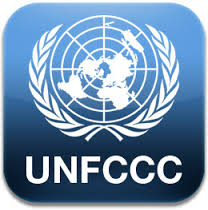UN Framework Convention on Climate Change (UNFCCC) – Conference of the Parties |
World leaders, dignitaries, and diplomats, from almost 200 nations (known as member nations), assemble every year for the United Nations Framework Convention on Climate Change . UNFCCC members assess international progress in mitigating global anthropogenic climate change.
. UNFCCC members assess international progress in mitigating global anthropogenic climate change.
Members also negotiate protocols and treaties between nations, further addressing the plethora of climate-related issues. The annual UNFCCC meetings are called Conference of the Parties (COP). Since 1994, the COP has convened annually at a different international city for meetings (the most famous COP being COP21 in Paris in 2015, commonly known as the Paris Climate Accord).
The COPs include the following international discussions:
- plans for global sustainability
- Nationally Determined Contributions (NDCs) vis-a-vis commitments to greenhouse gas emissions (GHGs) reductions
- updating urban planning guidelines with energy efficiency and green building in mind.
- as well as funding/ / further investment for research, development and deployment/ implementing-
- clean and renewable energy sources
- energy efficiency technologies
- sustainable mass transit and clean transit infrastructure projects
- green building projects
All of these discussions (among other global sustainability issues), discussed by UNFCC members at the COPs, are intended to produce viable solutions to meet the goal of dramatically reducing global GHGs. The Intergovernmental Panel on Climate Change (IPCC) advises that to avoid potentially catastrophic effects of climate change, world governments need to reduce GHGs substantially in order to keep global warming to “well below 2°C”; and ideally to no more than 1.5°C, this century.
COP21 – the Paris Climate Accord
Prior to Paris, the Kyoto Protocol and a few previous COPs tried to establish effective member nation commitments to lower global GHGs. The Kyoto Protocol was signed in 1997 and tried to operationalize the UNFCCC by having nations commit to efforts to limit GHGs. However, with Kyoto, developing nations were only encouraged to voluntarily reduce GHGs. The United States signed but did not ratify it, and ultimately, the Kyoto Protocol ultimately was not effective. In contrast, in 2015, the Paris Accord effectively gave rise to NDCs that every member nation has made.
 Almost every nation in the world has now ratified the Paris Climate Accord (all 197 member nations to the UNFCC have signed the Accord; 190 of the 197 nations have ratified the Accord and have also pledged NDCs). Even a few nation-states that aren’t in the UN, like the State of Palestine and the Cook Islands, signed as member nations to the Paris Climate Accord. The United States announced a pull-out from the Paris Accord, though this never really took effect; and President Biden brought the US back into the Paris Climate Accord.
Almost every nation in the world has now ratified the Paris Climate Accord (all 197 member nations to the UNFCC have signed the Accord; 190 of the 197 nations have ratified the Accord and have also pledged NDCs). Even a few nation-states that aren’t in the UN, like the State of Palestine and the Cook Islands, signed as member nations to the Paris Climate Accord. The United States announced a pull-out from the Paris Accord, though this never really took effect; and President Biden brought the US back into the Paris Climate Accord.
NDCs have progressed to the point where many nations have taken the step of pledging net zero GHG emissions (carbon neutrality). China has set their net zero target for 2060; and soon after, the US committed to net zero by 2050; and both of these net zero commitments followed earlier European carbon neutrality pledges. The EU has a net zero target of 2050, and a few European nations independently have the same, or even more ambitious, targets.
These net zero pledges represent ambitious goals to keep global warming well below 2°C (that’s 2°C rise above pre-industrial global temperature averages), and ideally to 1.5°C, this century; making good on the latest IPCC climate targets. In future COPs, such as the COP26 in Glasgow, Scotland, expect international net zero pledges to expand, and become a regular part of UNFCCC language; along with the term – ambitious climate targets.
For more details on NDCs, please see:
The Fight Against Climate Change – National Carbon Reduction Goals
Putting a Price on Carbon – Establishing Carbon Markets
Perhaps the most contentious topic to be discussed at the COPs is carbon pricing; systems in which governments can incentivize carbon-intensive industries, entire countries, and regions, to lower their GHG emissions by pricing carbon dioxide emissions.
Experts on climate mitigation policies believe that international carbon pricing systems may ensure the quickest path to net zero emissions (carbon neutrality). Individual nations, states, and provinces, continue to ultimately decide on carbon pricing legislation; as well as the inner workings of any carbon pricing system, including whether any potential national or regional carbon pricing system is to function as a carbon tax, or a cap-and-trade/ emissions trading system (ETS).
This process of high-level intergovernmental discussions of potentially mandating national prices on carbon could be encouraged by the UNFCCC in the future. If the UNFCCC took the step of directing nations to adopt carbon pricing, global warming would almost certainly be abated sooner than without prices on carbon emissions worldwide.
The European Union already does have carbon pricing – the EU ETS. Launched in 2005, the EU ETS has gradually evolved from a very low price on carbon, to a slightly higher one; and it’s expected that the European Commission will continue to increase the EU ETS carbon price with the continued evolution of climate ambition. Other European nations have independently developed an ETS and/ or a carbon tax; and many other countries, states, provinces, and regions worldwide, have also developed carbon pricing.
For more on carbon pricing around the world, please see: Putting a Price on Carbon. There has been significant progress made through recent COPs on the topic of carbon pricing, as described in this quote- “Leaders across the Americas have pledged to step up the use of carbon pricing as a key instrument of economic and environmental policy to reduce carbon emissions.” FROM- unfccc.int/news/leaders-across-the-americas-step-up-carbon-pricing.
There is currently a significant gap in the commitments that nations worldwide have made to reduce greenhouse gas emissions; and the reality of global warming still accelerating at a perilous pace. Green City Times has written about the–
Shortfall in International GHG Pledges
This following quote is by António Guterres, the current United Nations Secretary-General-
“In 2015, the world’s nations recognized the urgency and magnitude of the [global climate change] challenge when they adopted the historic Paris Agreement on climate change with a goal of limiting global average temperature rise to well below 2 °C; while aiming for a safe 1.5 °C target. The unity forged in Paris was laudable – and overdue. But, for all its significance, Paris was a beginning, not an end. The world is currently not on track to achieve the Paris targets. We need urgent climate action and greatly increased ambition – in emissions reductions and in promoting adaptation to current and future impacts of climate change.” FROM- unfccc.int/resource/annualreport
GCT tags
carbon footprint circular economy clean energy climate change compost composting eco-conscious eco-friendly eco-friendly materials electric vehicles energy-efficient appliances energy efficiency energy star energy storage environmental footprint environmental impact environmentally-friendly ESG global warming green building greenhouse gas emissions green infrastructure green spaces LED lighting LEED organic farming Paris Climate Accord recycling renewable energy smart thermostat solar solar energy solar panels solar power sustainability sustainable sustainable agriculture sustainable construction sustainable living sustainable materials sustainable practices sustainable transportation urban planning waste management water conservation
